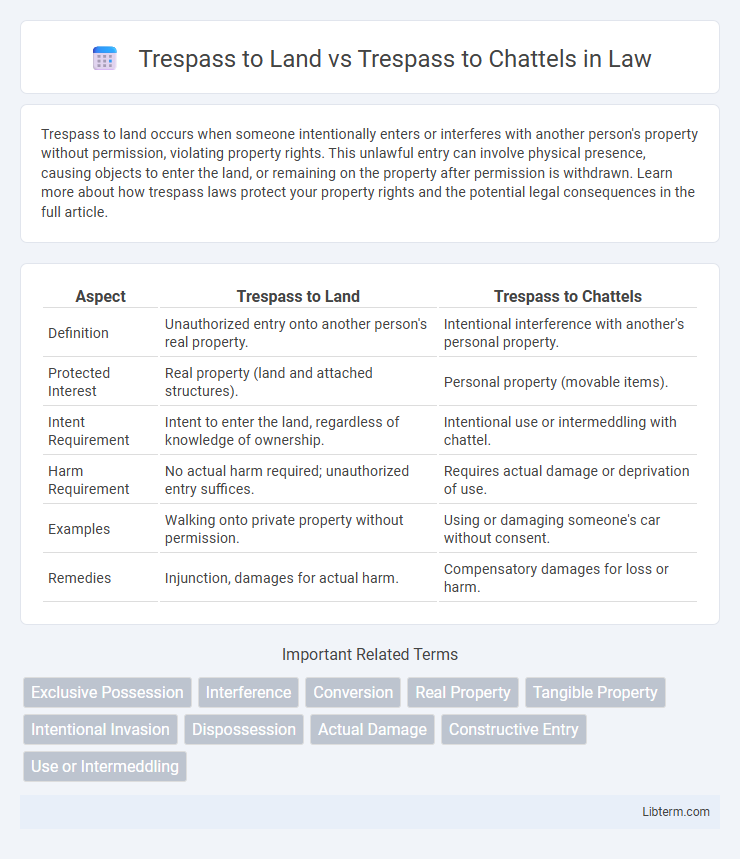Trespass to land occurs when someone intentionally enters or interferes with another person's property without permission, violating property rights. This unlawful entry can involve physical presence, causing objects to enter the land, or remaining on the property after permission is withdrawn. Learn more about how trespass laws protect your property rights and the potential legal consequences in the full article.
Table of Comparison
| Aspect | Trespass to Land | Trespass to Chattels |
|---|---|---|
| Definition | Unauthorized entry onto another person's real property. | Intentional interference with another's personal property. |
| Protected Interest | Real property (land and attached structures). | Personal property (movable items). |
| Intent Requirement | Intent to enter the land, regardless of knowledge of ownership. | Intentional use or intermeddling with chattel. |
| Harm Requirement | No actual harm required; unauthorized entry suffices. | Requires actual damage or deprivation of use. |
| Examples | Walking onto private property without permission. | Using or damaging someone's car without consent. |
| Remedies | Injunction, damages for actual harm. | Compensatory damages for loss or harm. |
Introduction to Trespass: Land vs Chattels
Trespass to land involves the unauthorized entry onto another person's real property, directly interfering with their exclusive possession rights. Trespass to chattels refers to the intentional interference with or damage to another individual's personal property, such as vehicles or belongings, without lawful justification. Both types of trespass protect different property interests: real property in land trespass, and movable personal property in chattels trespass.
Defining Trespass to Land
Trespass to land occurs when an individual intentionally enters or remains on someone else's property without permission, interfering with the owner's exclusive possessory rights. It includes physical invasion by a person, object, or structure that intrudes onto the landowner's property boundaries. Unlike trespass to chattels, which involves interference with personal property, trespass to land protects real property interests from unauthorized entry or occupation.
Understanding Trespass to Chattels
Trespass to chattels involves the intentional interference with another person's personal property without consent, causing harm or deprivation of use. Unlike trespass to land, which concerns real property, trespass to chattels focuses on tangible movable items such as vehicles, electronics, or tools. Legal remedies often include compensation for damages or loss of use rather than claim to the property itself.
Key Differences Between Trespass to Land and Chattels
Trespass to land involves unauthorized intrusion onto another person's real property, directly interfering with the owner's possessory rights, whereas trespass to chattels refers to the intentional interference with another's personal property without consent. The primary distinction lies in the type of property affected: land pertains to immovable real estate, while chattels are movable personal belongings. Legal remedies for trespass to land typically include injunctions and damages for any loss of use or harm, whereas trespass to chattels often results in compensation for damage or deprivation of property use.
Legal Elements Required for Trespass to Land
Trespass to land requires intentional entry onto another person's real property without permission, interfering with the owner's exclusive possession rights. The key legal elements include a physical invasion, the property must be tangible real estate, and the trespass must be unauthorized or unlawful. Unlike trespass to chattels, which involves interference with personal property, trespass to land protects immovable property rights under property law.
Legal Elements Required for Trespass to Chattels
Trespass to chattels requires intentional interference with another person's personal property without consent, causing dispossession, impairment, or damage. The plaintiff must prove that the defendant intentionally used or intermeddled with the chattel, resulting in harm to the property's condition, value, or possessor's use. Unlike trespass to land, which concerns real property invasion, trespass to chattels focuses on tangible movable objects and the unauthorized disruptions related to them.
Common Examples of Trespass to Land
Common examples of trespass to land include unauthorized entry onto private property, such as walking across someone's yard without permission, erecting structures that encroach on property boundaries, and leaving personal belongings on another's land without consent. Unlike trespass to chattels, which involves the intentional interference with movable personal property like damaging someone's vehicle or borrowing without consent, trespass to land centers on infringing the possessory interests in real property. Courts often focus on the physical invasion or occupation of land as the basis for trespass to land claims, emphasizing owners' rights to exclusive possession.
Common Examples of Trespass to Chattels
Common examples of trespass to chattels include unauthorized use or interference with another person's personal property, such as temporarily borrowing a laptop without permission or damaging someone's car by scratching the paint. Unlike trespass to land, which involves unlawful entry onto real property, trespass to chattels specifically targets tangible movable property, emphasizing interference that impairs possession or use. Legal claims often arise when the chattel is significantly damaged, deprived of use, or dispossessed, causing loss to the rightful owner.
Remedies and Damages for Each Type of Trespass
Remedies for trespass to land typically include injunctive relief to prevent ongoing or future intrusions, as well as monetary damages for any harm caused, such as loss of use or reduction in property value. In trespass to chattels, remedies often involve compensatory damages for actual harm to the personal property or its diminished value, and in some cases, the return of the chattel or its replacement. Courts may also award nominal damages to recognize the violation even if no significant damage occurred, reflecting the protection of possessory rights in both types of trespass.
Conclusion: Importance of Distinguishing Trespass Rights
Distinguishing between trespass to land and trespass to chattels is crucial as it determines the scope of legal protection and the type of remedy available. Trespass to land safeguards real property boundaries against unauthorized entry, while trespass to chattels protects personal property from direct interference or damage. Understanding these distinctions ensures accurate claims enforcement and tailored compensation for property owners.
Trespass to Land Infographic

 libterm.com
libterm.com